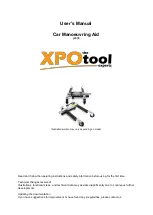
MOST 20-2B
iii
PACIFIC CONSOLIDATED INDUSTRIES
350003 Rev D
WARNING:
Periodically check the surface
temperature of the cylinders during charging
operations. Allowing excessive heat to build up in
the gas will result in a failure of the seals in the
cylinder valves and possible ignition.
WARNING:
Never shut off a line without verifying
that a suitably rated relief valve or bleed off valve
has been installed between the two shutoff valves.
Failure to do so can result in a rupture of the line
and possible ignition.
WARNING:
Never charge cylinders with oxygen
that are marked for other gases. Always check the
cylinder markings and ensure that only cylinders
marked for oxygen are charged with oxygen.
Failure to do so can result in contamination of the
patient oxygen supply.
SAFE PRACTICES FOR HANDLING AND
OPERATING OXYGEN EQUIPMENT
Oxygen used in the medical profession can be very
hazardous. Although oxygen does not burn, it does support
combustion. A material, which will not burn in air, may
burn in a high-pressure pure oxygen - such as the metal in
oxygen regulators or cylinders. Some general guidelines
for minimizing the chance of fire are provided below:
STORAGE, MAINTENANCE AND
HANDLING
•
Do not allow smoking around oxygen.
•
Store oxygen in clean, dry locations and away
from direct sunlight.
•
Do not allow valves, regulators, gauges, and
fittings to come into contact with oils, greases,
organic lubricants, rubber or any other combustible
substance.
•
Make sure that any cleaning, repair or transfilling
of oxygen equipment is performed by qualified,
properly trained staff.
•
Do not work on oxygen equipment with ordinary
tools. Designate special tools, clean them and store
them for “Use With Oxygen Equipment Only”.
•
Use plugs, caps and plastic bags to protect “off
duty” equipment from dust and dirt.
USE
•
Make sure that personnel using oxygen equipment
are adequately trained in its operation and in
oxygen safety and have knowledge of
manufacturer’s instructions for using the
equipment.
•
Open the cylinder valves slowly and completely to
minimize the heat produced and achieve the
desired flow conditions within the equipment.
WARNING:
Composite cylinders require
Hydrostatic Testing at five (5) year intervals.
Check Hydrostatic Test plate prior to filling to
ensure cylinders testing is current.
Relief Valves require testing at (2 to 3) year
intervals to ensure accuracy.
NOTE:
IT IS RECOMMENDED THAT THE
TESTING BE PERFORMED AT THE PCI
FACILITY
HYDROSTATIC TESTING
Cylinders must be re-inspected and hydrostatically retested
at least once every five years. Testing must be performed
in accordance with DOT-CFFC-13 tested to 5/3 of the
marked service pressure, 49 CFR S 180.205, the latest
edition of CGA pamphlet C-6.2, and DOT-E 13250.
CERTIFIED TESTING STATION
The testing facility must be approved under DOT 49
CFR-180.205, part 1, part 107.





































